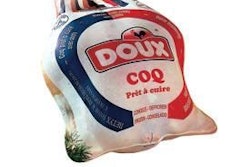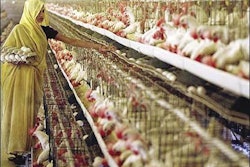No-one can hope to control an infectious disease successfully without first having a clear understanding of how it spreads between pig units. To give a simple example, a breeding herd cannot eliminate the PRRS virus from its animals by test-and-remove techniques while it still purchases semen from a PRRS-positive AI centre. Know-how about the various ways in which a disease can spread must also be behind the biosecurity measures aimed at controlling it.
Therefore it is worth taking a moment to refresh your own knowledge and that of your workers regarding the possibilities for transmitting an infection between the pigs of the enterprise.
Spread by pigs
This must always be considered as the most important risk factor. Remember the saying that the greatest disease threat to a pig is another pig. Actively infected pigs shed large quantities of pathogens, especially just before and during the clinical signs of that infection. These pathogens can be in exhaled air, saliva, faeces, urine, semen, skin debris and foetal material — and are then capable of infecting other pigs.
Isolation is a valuable weapon. To prevent a farm becoming infected by the direct pig route means locating it away from other pigs and related businesses. It must also be away from pig transportation routes and have secure perimeters to stop the access of stray or feral pigs. The disease breakdown risks are obviously higher for a farm located in a very pig-dense area or close to other herds.
In an effort to control spread of pathogens within a production system, pig flows have been built up segregating different ages on different sites, in different buildings or different rooms. These have generally been very successful at reducing spread. But these systems bring decreased immunity and increased susceptibility to any new pathogen, so it is essential that their biosecurity is maximised.
A unit that purchases pigs must do so from a source free from the pathogens it is trying to control. This needs to be based on veterinary communication, adequate testing and a sound knowledge of the supply herd. Ongoing communication is needed where growing pigs are being purchased. When the animals bought are for breeding, it is normal to health-match with the supplier. Isolation of incoming breeding stock will increase herd protection (it is usual to isolate for 30-90 days). During this period a strategy of good acclimatisation, controlled exposure to recipient herd pathogens and appropriate vaccination will promote immunity in the new pigs and prevent them destabilising the main herd when they enter. Biosecurity between the isolation facility and main herd must be maintained. Good external biosecurity of the isolation place is mandatory.
Semen and embryos are also potential means of spread of disease. Match the health of these in a similar way. Appropriate testing can be done on the supply farms or genetic material. Extra protection in extreme circumstances can be gained by freezing semen to allow checking of the source herd for a period after collection, but fertility will be reduced.
Spread by faeces and urine
Many pathogens are spread via manure. It can happen through the operation of push-through or scraper clearing systems in dung channels as well as by leakage or mechanical spread. Pathogens in faeces and urine can be spread between farms when carried mechanically (such as on a vehicle) or when spread as slurry onto land near another farm. Aerosol spread from slurry sprays may be a concern.
Within a farm, the possibility for mechanical spread is reduced by cleaning and disinfecting all equipment moved between buildings using a broad-spectrum disinfectant. Pay attention to areas where pigs may be exposed to faeces from other pigs, for example in walkways and passages. Try to control movement of equipment and people between different buildings.
Faecal/urine spread of disease agents between sites is reduced by controlling the movement of people and equipment, also by vehicle biosecurity and arranging the non-transference of equipment. Slurry and manure spreading must be controlled by local agreements.
Aerial spread
Aerial spread is commonly said to be a major method of disease transfer. It is true that the virus of foot-and-mouth disease has been demonstrated to spread at least 100 kilometres in favourable conditions (cold, humid and across water) and Mycoplasma hyopneumoniae and Actinobacillus pleuropneumoniae (APP) can spread a few kilometres. However, the aerial spread of other pathogens is much less easy. PRRS virus is an important example. It was initially thought to spread easily via the aerial route, but is now realised to travel one kilometre only on rare occasions. Frequently, the distance it travels is much less than 1km.
In sealed buildings, aerial spread can be prevented by the use of adequate filters on air inlets. This has worked well on boar studs in pig-dense areas, but current technology makes this less effective on larger commercial units and naturally-ventilated buildings. Trials using a broad-spectrum disinfectant showed that periodic fogging into the air significantly reduced aerial spreading of pathogens between and within buildings.
Spread by humans
Spread of pathogens by humans is a difficult problem to address. On the one hand people can be important spreaders of pathogens, but on the other hand over-zealous requirements to prevent this possibility have given rise to real logistical problems.
Humans can carry pathogens mechanically on clothes, skin, hair or boots or internally in their respiratory or digestive systems. Controlling this type of spread requires limits on people movement and access. Staff entering a facility should at least have clean clothes and change outer clothing and boots. Ideally they should shower. Within the unit, boots should be dipped in clean fresh foot-dips using an appropriate virucidal disinfectant such as Virkon S, but must be clean before dipping. Require the workers to dip their boots at least between every building. Hands should be washed using a bactericidal soap.
Movement of people between different stages of production should be discouraged. Where it is unavoidable, it should always be from younger to older pigs.
Downtime free from pigs as a requirement for entry into a healthy unit is a contentious area and one that needs further research. Traditionally, healthier units required at least 2 nights of freedom from contact with pigs prior to entry. This was based on work done many years ago on foot-and-mouth disease virus. There is mounting evidence that this is excessive and that in most cases 1 night or less is adequate when coupled with a change of clothing and a shower.
Spread by other animals
Pathogens can be spread by other livestock. Examples would be by cattle and sheep (foot-and-mouth disease), by wild animals (classical swine fever/hog cholera from wild boar), by pets (Salmonella spread by cats), by birds (influenza), by insects (Streptococcus suis and PRRS by flies) and by rodents (Brachyspira hyodysenteriae by mice).
Spread can either be mechanical (carried on the body of the animal) or biological (the agent replicates in the other animal's body). The other animals may or may not exhibit clinical signs of disease. In extreme circumstances some organisms can be carried a very long time. For example, Brachyspira hyodysenteriae can survive in the guts of mice for 180 days.
Control of spread by other animals is really based on excluding them. Many will be excluded by a good perimeter fence. Rodent control programmes should be instituted. Building design should help control rodents, exclude birds and keep out flying insects. Obviously outdoor units or units reliant on natural ventilation present greater challenges.
Spread by vehicles
There are many vehicles that come into contact with pigs or farms and which potentially can spread pathogens. Pig transport vehicles constitute the greatest risk, but remember others including feed trucks, service vehicles, trucks removing organic waste and dead pigs, also the cars of farm staff.
Controlling this type of spread is based on good planning and protocols. Aim to exclude vehicles from the farm. This can be aided by effective farm design, with appropriate stock loading and unloading facilities and food deliveries being from outside the perimeter fence. All vehicles approaching the farm should be cleaned and wheels sprayed with a disinfectant or pass through a disinfectant wheel dip. However, disinfection will be less effective if there is excess dirt and organic material on the wheels or wheel-arches.
Vehicle downtimes and scheduling can present a real problem and individual farm requirements need to be carefully assessed, but remember not every farm can have first delivery. Be aware of the risk posed by people within the vehicle. For example, do not allow the driver of a live-haulage vehicle to walk down the loading ramp into the farm. Items such as toolboxes carried in the vehicles can also present risks.
Spread by food and water
Perhaps the best example of a pathogen spread by food to pigs is Salmonella when it is passed from incorrectly produced or treated feed. Feeding animal by-products in swill is now illegal in many countries and should be avoided. The potential for human food to act as a vehicle for pathogen transmission has been shown on several occasions when food scraps reached the animals.
Water can also transmit pathogens. Contaminated supplies, uncovered header tanks and poor delivery systems are all potential problems, as are biofilms building up in a water system. Examples of pathogens which might be spread include E. coli, Salmonella and PRRS (which has been shown to have lasted for 11 days in a water system after pigs left the facility). To control spread in the water, use a proven, broad-spectrum disinfectant which can be used as a terminal disinfectant and also while pigs are drinking.
Spread by fomites
Fomites are defined as inanimate objects that can harbour a pathogen and serve as an agent of transmission of that pathogen. Within pig production there are many fomites. It would be impossible to list them all, but to give some examples: injection needles; contaminated medicine bottles; handling equipment (such as an ultrasound scanner); boots and clothing; and finally buildings can transfer pathogens from one batch of pigs to the next.
Obviously within such a cross-section of risks it is not possible to give specific instructions for every case. The farmer or biosecurity manager and the veterinarian need to spend a large amount of time assessing possible risks and their control. Often the control measures can be simple, such as dipping clean boots in a footdip between rooms, changing injection needles frequently and instituting a thorough decontamination protocol for deliveries (possibly involving chambers using nitrous oxide or aerial disinfection). In many cases the establishment of good working protocols is a vital part of control. A simple instance is the insistence that equipment must not be shared between farms and that visitors wear farm-supplied overalls and boots.
A complete programme of terminal cleaning and disinfection is essential to prevent the carryover of pathogens between batches of pigs using the same buildings. This must involve the removal of gross organic debris, followed by pressure washing using a heavy-duty detergent and disinfection using a broad-spectrum disinfectant. Care should be taken with all removable equipment; the water system must be treated. Specialist disinfecting agents may need to be used if specific pathogens are involved and aerial disinfection can be of use to reach inaccessible areas.
Local or neighbourhood spread
In most studies of major disease outbreaks it became obvious that there were occasions where spread had occurred in a locality without a specific reason being identified. By definition, such spread occurs where farms are close together. It might be due to any number of factors including by rodents, insects or aerosol. To control this type of spread between close farms requires the very highest levels of biosecurity and can be very difficult to achieve. Obviously the best method of avoiding it is by keeping farms well apart.
Unknown spread
There are cases where a pathogen spreads to a farm and there is no attributed cause of spread. Also there are some diseases where we are not sure how they spread. An example there is PMWS/PCVAD. Attempting to control this sort of pathogen is a real worry. How can you prevent something if you do not know how it happened?
Of course, it will always be a major challenge in practice to prevent pathogens from spreading. The temptation will be to say attempting prevention would be too much trouble and too expensive. This is absolutely wrong. We have only to look at the cost of disease and a specific outbreak to know it is worth the effort.

















